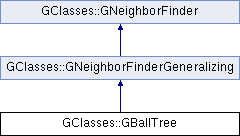An efficient algorithm for finding neighbors. Empirically, this class seems to be a little bit slower than GKdTree.
|
| | GBallTree (const GMatrix *pData, GDistanceMetric *pMetric=NULL, bool ownMetric=false) |
| |
| virtual | ~GBallTree () |
| |
| void | drop (size_t index) |
| | Drops the specified index from this ball tree. Throws an exception of the specified index is not found in the tree. Note that the tree still assumes that the other indexes still retain their relationship with the points in the dataset that was used to construct this object, so you should not move the rows in that dataset around. Also note that before you call reoptimize, you need to delete any rows that were dropped, or else they will then be added back in. More...
|
| |
| void | dropAll () |
| | Drops all of the leaf point indexes, but retains the interior structure. (This might be useful if you know in advance which points will be inserted, but you don't want them to be in the tree yet.) More...
|
| |
| virtual size_t | findNearest (size_t k, size_t index) |
| | See the comment for GNeighborFinder::findNearest. More...
|
| |
| virtual size_t | findNearest (size_t k, const GVec &vec) |
| | See the comment for GNeighborFinderGeneralizing::neighbors. More...
|
| |
| virtual size_t | findWithinRadius (double squaredRadius, size_t index) |
| | See the comment for GNeighborFinder::findWithinRadius. More...
|
| |
| virtual size_t | findWithinRadius (double squaredRadius, const GVec &vec) |
| | See the comment for GNeighborFinderGeneralizing::findWithinRadius. More...
|
| |
| void | insert (size_t index) |
| | Inserts a new point into this ball tree. This method assumes you have already added a new row to the dataset that was used to construct this tree. Calling this method informs this structure that it should also index the new point. Note that this method may reduce the efficiency of the tree by a small amount, so you might want to call reoptimize after several points are added. More...
|
| |
| virtual void | reoptimize () |
| | Rebuilds the tree to improve subsequent performance. This should be called after a significant number of point-vectors are added to or released from the internal set. More...
|
| |
| void | setMaxLeafSize (size_t n) |
| | Specify the max number of point-vectors to store in each leaf node. More...
|
| |
| | GNeighborFinderGeneralizing (const GMatrix *pData, GDistanceMetric *pMetric=NULL, bool ownMetric=false) |
| | Create a neighborfinder for finding the neighborCount nearest neighbors under the given metric. If ownMetric is true, then the neighborFinder takes responsibility for deleting the metric, otherwise it is the caller's responsibility. More...
|
| |
| virtual | ~GNeighborFinderGeneralizing () |
| |
| virtual bool | canGeneralize () |
| | Returns true. See the comment for GNeighborFinder::canGeneralize. More...
|
| |
| virtual double | distance (size_t i) |
| | See the comment for GNeighborFinder::distance. More...
|
| |
| GDistanceMetric * | metric () |
| | Returns the metric. More...
|
| |
| virtual size_t | neighbor (size_t i) |
| | See the comment for GNeighborFinder::neighbor. More...
|
| |
| void | sortNeighbors (size_t start=0, size_t end=INVALID_INDEX) |
| | Uses Quick Sort to sort the neighbors from least to most distant. More...
|
| |
| | GNeighborFinder (const GMatrix *pData) |
| |
| virtual | ~GNeighborFinder () |
| |
| const GMatrix * | data () |
| | Returns the data passed to the constructor of this object. More...
|
| |
| virtual bool | isCached () |
| | Returns true iff the neighbors and distances are pre-computed. More...
|
| |
|
| GBallNode * | buildTree (size_t count, size_t *pIndexes) |
| | Build the tree. More...
|
| |
| size_t | findNearest (size_t k, const GVec &vec, size_t nExclude) |
| | This is a helper method that finds the nearest neighbors. More...
|
| |
| size_t | findWithinRadius (double squaredRadius, const GVec &vec, size_t nExclude) |
| | This is a helper method that finds the neighbors within a specified radius. More...
|
| |
| void | insertionSortNeighbors (size_t start, size_t end) |
| | A helper method used by sortNeighbors when the remaining portion to sort is small. More...
|
| |

 Public Member Functions inherited from GClasses::GNeighborFinderGeneralizing
Public Member Functions inherited from GClasses::GNeighborFinderGeneralizing Public Member Functions inherited from GClasses::GNeighborFinder
Public Member Functions inherited from GClasses::GNeighborFinder Protected Member Functions inherited from GClasses::GNeighborFinderGeneralizing
Protected Member Functions inherited from GClasses::GNeighborFinderGeneralizing Protected Attributes inherited from GClasses::GNeighborFinderGeneralizing
Protected Attributes inherited from GClasses::GNeighborFinderGeneralizing Protected Attributes inherited from GClasses::GNeighborFinder
Protected Attributes inherited from GClasses::GNeighborFinder